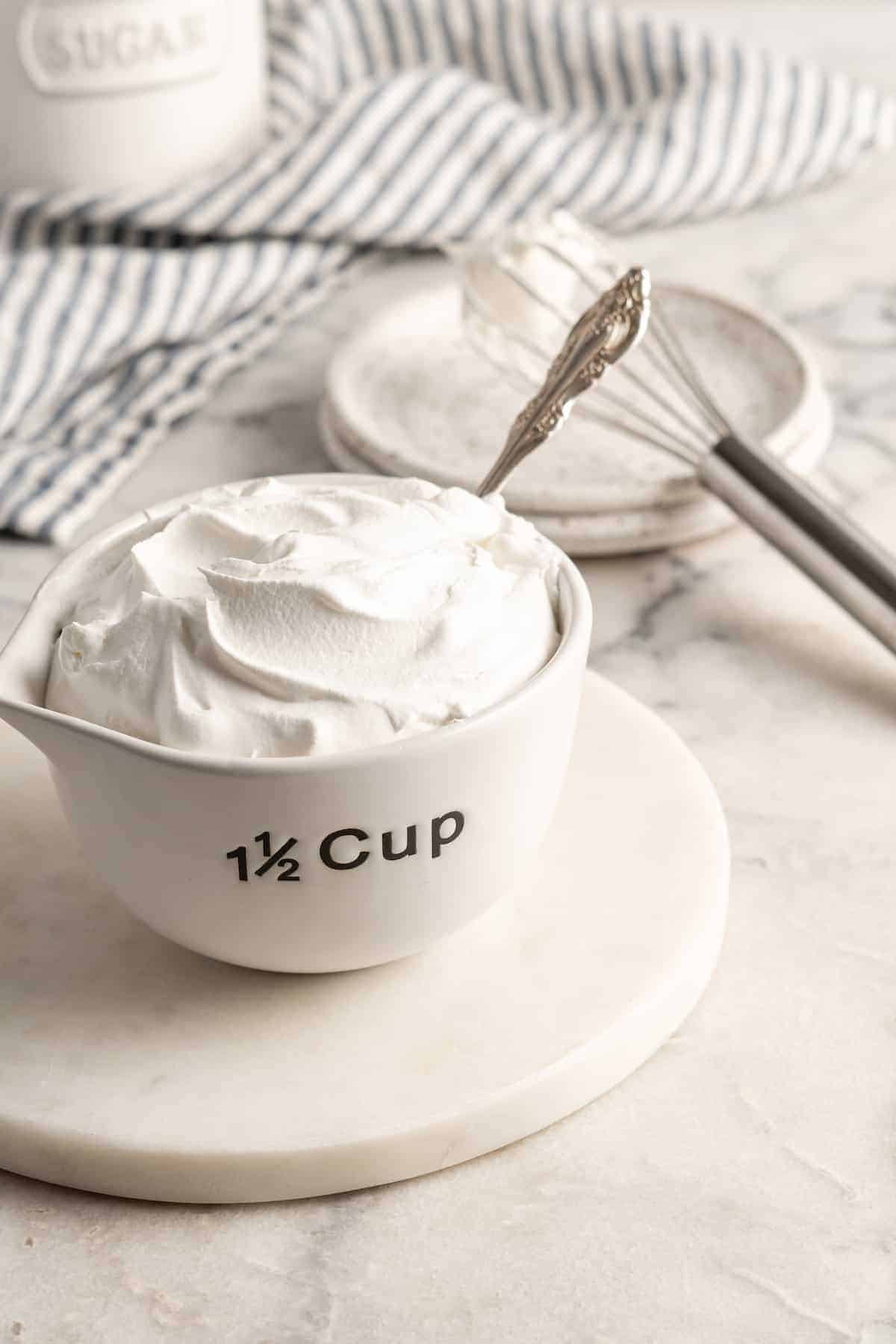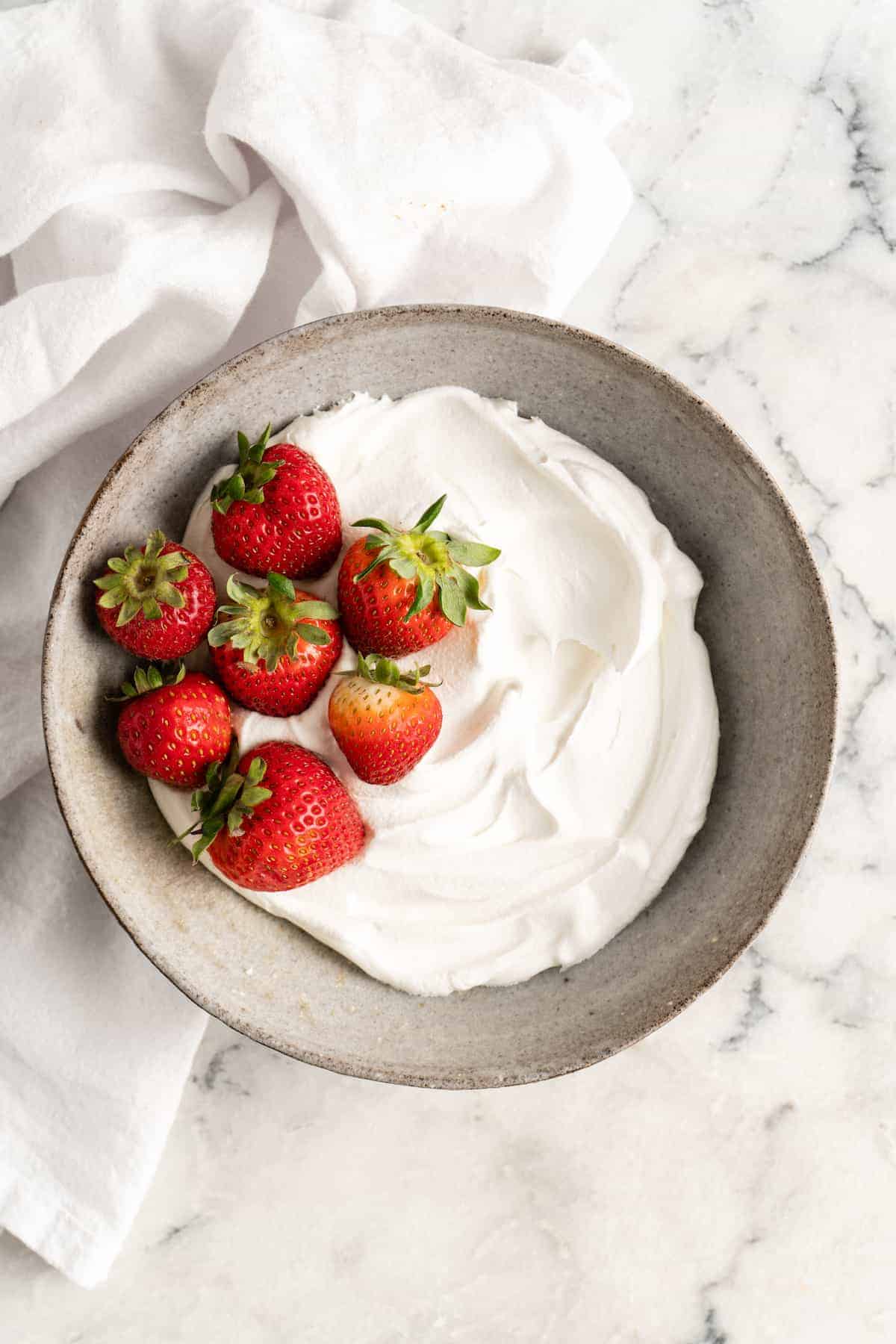Coconut Whipped Cream is an easy vegan whipped cream that’s so good it’s almost unreal! All you need are two ingredients for a dreamy plant-based whipped cream alternative.
Everyone needs a good homemade whipped cream recipe and if you’re vegan that can be hard to come by. Sure you could settle for store-bought, or you could just do without, but let’s face it – some recipes NEED whipped cream!
For example, if you’re making a vegan pecan pie or pumpkin pie for the holidays, a dollop of whipped cream takes an already incredible dessert and just makes it extra.
Luckily this recipe is incredibly easy to make. Coconut whipped cream is basically coconut cream that’s been thickened in the fridge and whipped with powdered sugar, resulting in a thick and creamy vegan whipped topping. It’s perfect if you’re vegan, have dairy sensitivities, or just want a lighter whipped cream option. This has become my go-to plant-based whipped cream since it’s less expensive than the store-bought varieties and tastes so much better!
Chilling overnight is key or the coconut cream won’t harden and will likely be too soft to whip. Before whipping, chill a large mixing bowl in the freezer for 10 minutes! If your coconut whipped cream is too stiff when whipping, add some of the reserved liquid from the can to help it blend smoother and create more air!

How to Make Vegan Whipped Cream
Technique matters when you’re making coconut whipped cream. Follow these steps to the letter!
- Prepare. Place a can of full-fat coconut milk in the refrigerator overnight. When you’re ready to make your whipped cream, open the can and scoop out the thick solids that are at the top. Stop when you get to the liquid—this is coconut water and you can drink it or add it to smoothies, but you don’t want it in your coconut whipped cream because it will make it thinner! Place your mixer bowl in the freezer for about five minutes to chill.
- Make the whipped cream. Once the mixer bowl is frosty, remove it from the freezer and place the coconut cream in it. Add the powdered sugar, then use a hand mixer or stand mixer to combine until the mixture is thick and creamy.

- Chill. Transfer the whipped cream into a resealable bowl or container and place it in the fridge. It will thicken even more once chilled.
Tips for Success
Here’s how to make perfect vegan whipped cream:
- Full-fat coconut milk or coconut cream is key. Don’t use the refrigerated cartons or bottles of coconut milk or the cans of lite coconut milk. They won’t whip up into coconut whipped cream!
- Sometimes you have to accept defeat. Okay, so this isn’t exactly a tip for success, but here’s the thing: coconut milk can vary from one brand to the next and even one batch to the next. Sometimes, you’ll get a can that won’t whip up into a nice consistency. This is disappointing, but remember that it’s not you, it’s the coconut milk! Try using Native Forest, Whole Foods, or Thai Kitchen for best results.
- Too thin? If you find that your coconut whipped cream is not thickening, you can add some tapioca starch to it—a teaspoon at a time should do the trick.
- Too thick? If the coconut cream is especially hard, it might be difficult to whip. Add coconut water from the can a tablespoon at a time until the mixture reaches a whipped cream consistency.

Basically, everything you do with traditional whipped cream, you can do with vegan whipped cream! Use it to top a slice of pie, put a dollop on an ice cream sundae, float it in your favorite latte, or just use it to dip fresh fruit.
This vegan whipped cream recipe is super versatile! Try adding any of these:
- Vanilla extract
- Almond extract
- Peppermint extract
- Ground cinnamon
- Pumpkin pie spice
- Instant coffee
- Matcha powder
Whipping Cream Won’t Whip
FAQ
How do you fix runny coconut cream?
How long does it take to whip coconut cream?
Why is my coconut whipped cream runny?
What if coconut whipped cream doesn’t whip?
If your coconut whipped cream doesn’t whip, try adding 1-3 tablespoons of tapioca flour while whipping. You can also thicken the coconut whipped cream by putting it in the refrigerator. Place it in the fridge for at least 2-3 hours to let it firm up.
What are the nutritional values of whip cream?
The whipped cream is a source of choline and fat-soluble vitamins such as, vitamins A, D, E, and K which are present in milk fat. The vitamins from whole milk can help to prevent osteoporosis and promote a good vision. However whipped cream is very rich in calories, each 100 grams of whipped cream contains approximately 300 calories, 30 grams of lipids and 20 grams of carbohydrates, thus it should be consumed in moderation.
What if whipped coconut cream is too thick?
If the whipped coconut cream is too thick or lumpy, add one teaspoon or more coconut milk and whip more to get the desired texture. Don’t overwhip. If you overwhip the cream, you will get a grainy textured cream instead of soft and fluffy peaks. Instead of artificial sweeteners, you can use honey or maple syrup as an alternative.
Why does coconut cream need to Chill before whipping?
The major reason is that you didn’t allow it to chill well in the fridge. The chilling step is important to separate hard solid coconut cream from the liquid. You will get a creamy soupy whip if it doesn’t chill enough. I recommend allowing it to chill for about 24 hours or overnight before whipping.
